Many of the prospective clients expect the SEO practitioner to provide specific data on the traffic growth and conversions they can expect to see at the stage of the marketing effort before starting. The concept of “SEO performance estimation” then arises. In this article I will try to answer the question: what factors should be paid attention to when performing SEO estimation?
To begin with, it is necessary to clarify what exactly is estimation. According to the definition, it is the estimation of the parameters of the distribution of a random variable in the population. From the point of view of SEO, the result of estimation is to determine an approximate final value (in this case, traffic and conversions) based on a previously collected pool of data on the search parameters we are dealing with.
It is worth mentioning that all of the following factors are based on averaged data. Therefore, it is important to realize that the estimation result will also be an approximation of what a website owner can achieve.
What is important – the greater the number of variables overlaid, the closer the estimation will be to reality.
.
Let’s analyze the factors that can affect the outcome of an SEO estimation. To do this, let’s trace the path of a user who may become a potential customer. In other words, let’s answer the question, how does a user get to a site from a search engine? The graphic below shows the simplest path from typing in a word to making a conversion:
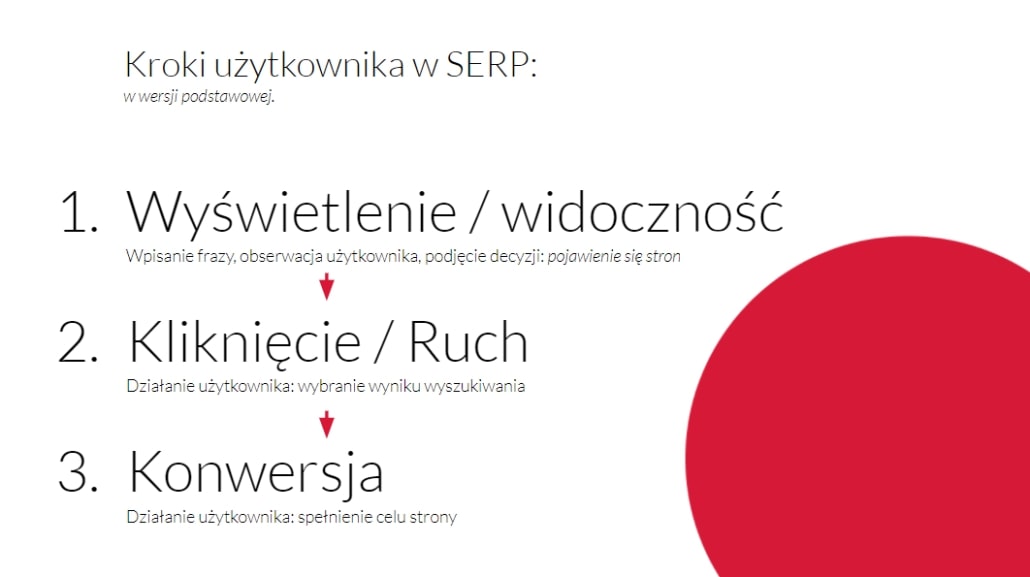 .
.
Why is this important? This path may seem obvious, while performing the estimation, we need to know what elements affect it at each stage. The parameters we take as we go through these 3 user steps will significantly affect its final result.
First step: display/visibility
.
Enter the phrase, observe the user, make a decision: appearance of the page in the SERP.
It can be assumed that a search engine is a huge library of information that is maintained on servers distributed in the cloud. This information is data with links to, among other things, company websites, stores, blogs, which are visible when specific phrases, otherwise known as keywords, are typed into the search engine. The visibility of a single page is nothing more than the sum of the words for which it displays in the search engine in the first hundred results.
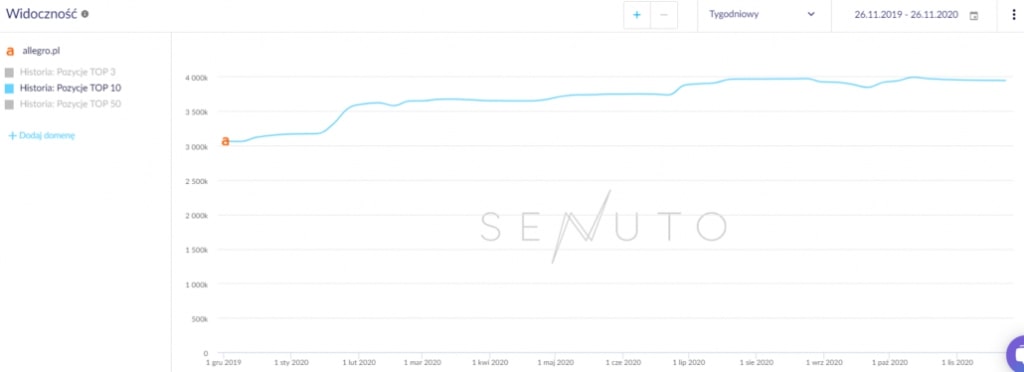
.
The key element of the estimation will be the number of words for which we will perform it. These do not have to be phrases that are currently visible in Google (especially for new sites). However, most often we want to get an answer to the question: I am in position x, what will happen if I am in position y? Therefore, it is necessary to determine the starting point of the position for each phrase.
Estimation variable: setting the starting point of the estimate
Second step: click / traffic
.
User action: selecting a search result.
All the work we do in Google search comes down to getting a user to the site. Preferably one that will be interested in our services or products. To have a chance to do this, you need to get your site displayed in the TOP 10 of search results, i.e. on the first page of the SERP (Search Engine Result Page). It is then significantly increased the probability of going to your site, as shown in the chart below:

For information on CTR, see later in this article.
Estimation variable: probability of clicking / going to the landing page (CTR).
Third step: Conversion
.
With a conversion, we can define the action expected by the site owner to be performed by a user in response to a targeted online advertising campaign (including SEO activities). A conversion occurs when a user performs an important action for your site, for example:
- submits a form,
- makes a purchase,
- will download a document,
- fulfills another defined purpose,
.
.
.
.

.
Depending on the type of site we are dealing with, the conversion rate will be fetched from Google Analytics from the ecommerce module (in the case of a store) or the goal achievement report (e.g., in the case of a services site). It is important that it is taken from the organic traffic report.
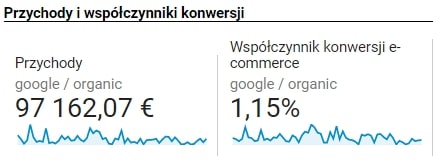 .
.
Estimation variable: probability of making a conversion (conversion rate)
CTR (Click Trough Rate) and its components
.
At this point we come to one of the most important components (mentioned earlier) that will affect the estimation performed. We are talking about the CTR. As a reminder, let’s give the formula:
 .
.
The key is to break down the components of this formula in terms of what kind of search we are dealing with. The graphic below shows the search components that will be the CTR modifiers for a single keyword.
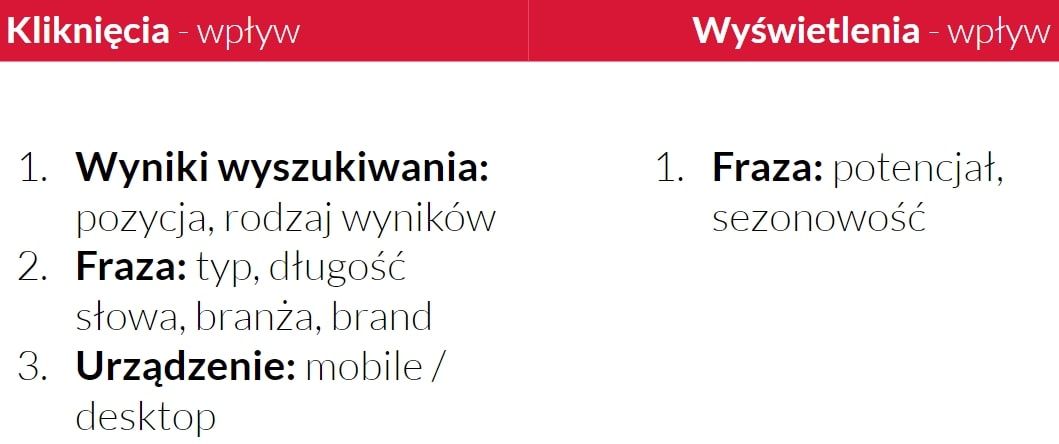
We can find real data on the average CTR for current keywords and their positions in the Google Search Console report in the Effectiveness tab.
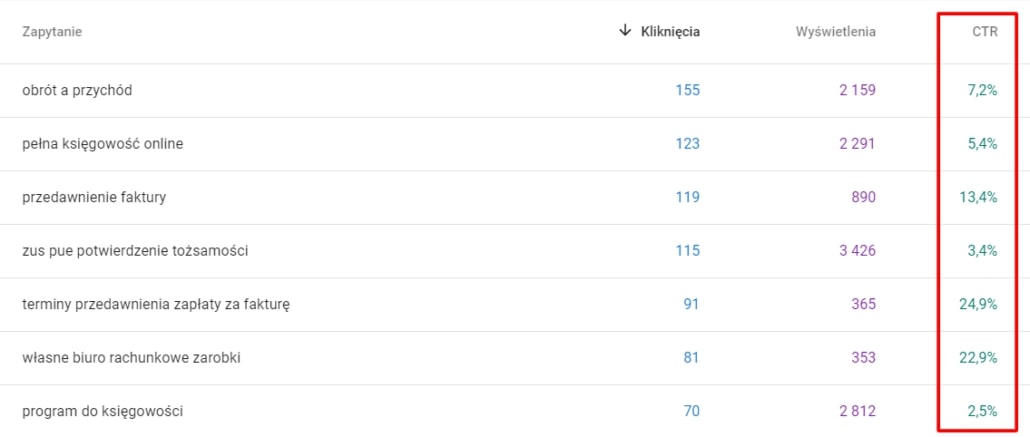 .
.
.
Search results
.
Position.
As a rule, the higher the position of a page in the search results, the higher the chance of a click, as presented in the graphic below – there is a smooth gradation of CTR from position 10 to 1. However, it shows the simplest version of search results, which is practically no longer present in the current version of Google’s search engine.
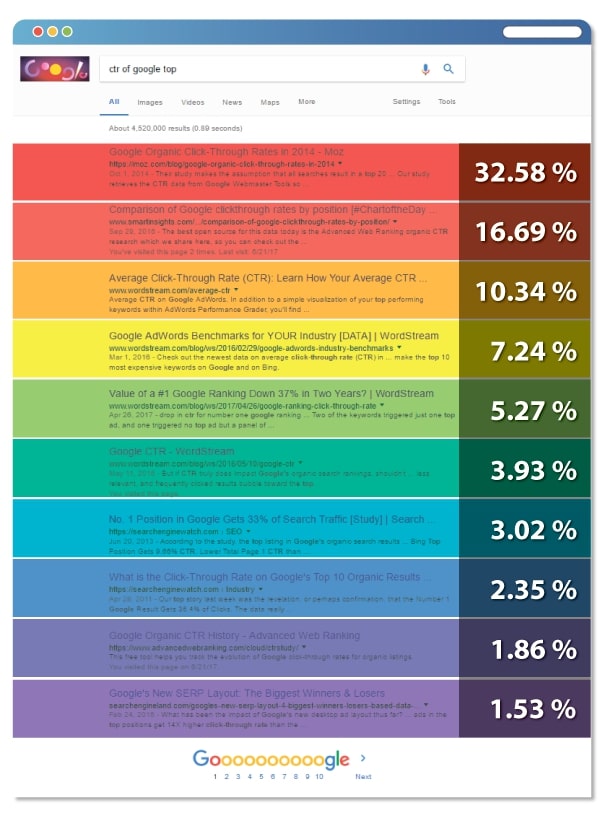
.
Therefore, it’s a good idea to include in your estimation a modifier related to the type of results that appear for a given keyword.
Type of results.
Over the years, search results have evolved – elements have appeared in them that have significantly influenced the click-through rate on individual links. Below is an example of organic results for the word “seo”:
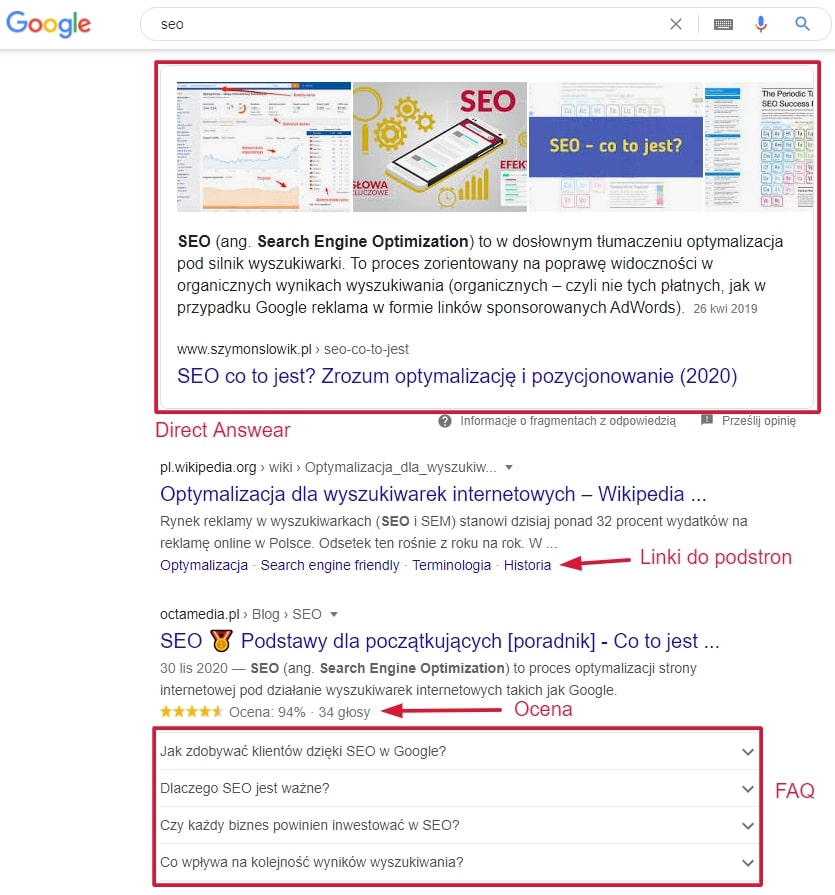 .
.
.
What will positively affect the CTR? The possibilities are as follows:
- optimized title and description,
- appraisals next to products,
- an FAQ section,
- links to sections/subpages,
- emoji,
- Google business card,
.
.
.
.
.
.
Phrase
.
Keyword type and length.
Search engine users have different needs and therefore different intentions. The following table shows the most popular types of keywords along with their characteristics.
| type | Transaction | Informational | Navigation | ||||
| User | Willingness to convert. | Willingness to convert. | Willingness to receive a response. | User. | Willingness to navigate to the desired landing page. | Willingness to convert. | |
| Characteristics | The majority of keyword phrases with commercial intent are in this category. | The majority of keyword phrases with commercial intent are in this category. | The most numerous group of words. Often phrases start with question words like “how”, “where”, “when”. | The majority of phrases with commercial intent are in this category. | Frequently contain the brand name. Large CTR for the first position. | ||
| Example of a phrase | the samsung q80t TV | how to size a TV orwhat is hdr | samsung login |
In addition, the following conclusions can be drawn:
- Information phrases (fact-related) and navigation phrases have very high CTR on the highest positions, but much worse on the further ones,
- The longer the word (more precise) with commercial intent, the greater the chance of conversion,
- The longer the query and/or involves an informative phrase (related to opinion), the more results users browse. Short queries record virtually no clicks in the second ten search results,
- The shorter the phrases, the lower the CTR. Single-word phrases only record clicks for 46% of searches.
.
.
.
It is important to note that at the stage of a user’s conversion, there are most often multiple keywords with different intentions (especially for more expensive products like laptops, credit or leasing), as the following funnel illustrates well:
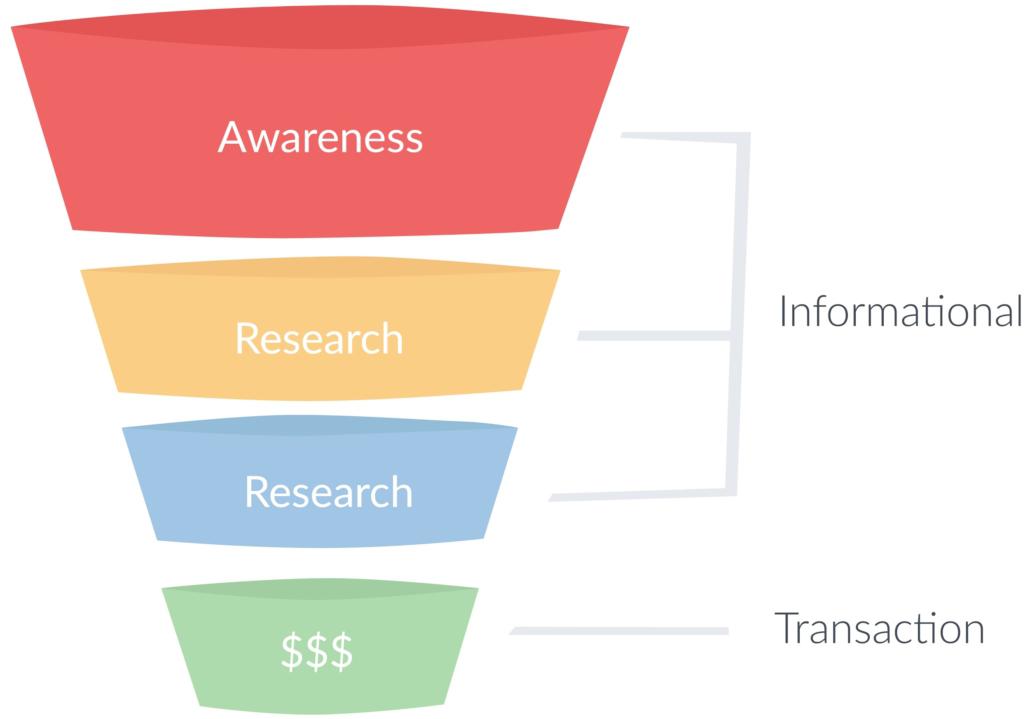
Branch/Brand.
For each estimate, top-down or for each keyword, assign the industry it belongs to. In the chart below, you can see that each industry has its own characteristic click-through rate per position.
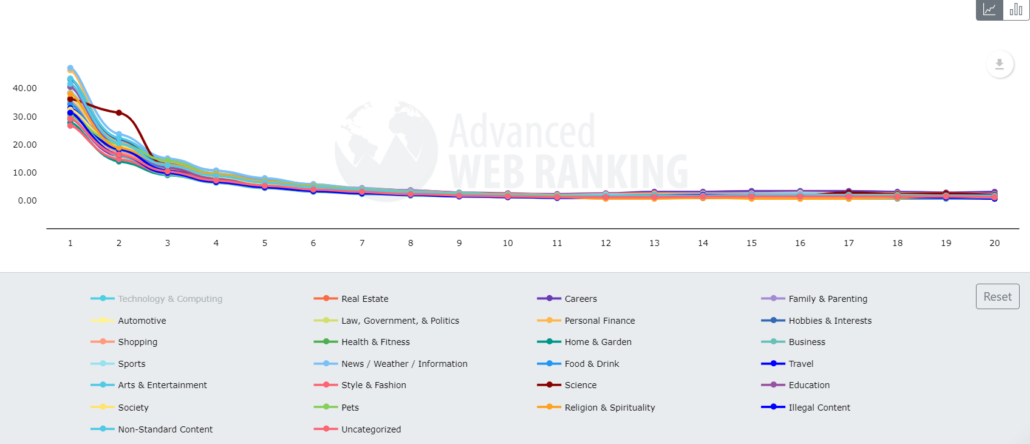
The situation is analogous for words with and without brand name – as can be observed in the chart below..
 .
.
- The average first position for phrases containing branding has by far the highest CTR, which is natural, since when we type in a brand name, we usually have the intention of going to a specific website.
- We can also see that words with branding result in a higher frequency of going to the second page of results – research on the product. But also a better click-through rate of the first positions due to the search for a specific company’s website.
Device
.
Mobile / desktop.
The share of users on mobile devices and desktop computers is also not insignificant. It can be assumed that the most common distribution of website traffic is ~60% / 40% (taking into account that we count tablets as mobile devices). In addition, the first result on desktop achieves on average a higher CTR than on mobile.
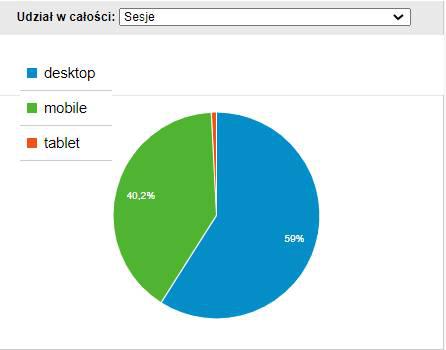 .
.
.
Phrase views
.
Potential/seasonality.
One of the more authoritative metrics to consider is the number of searches for a given keyword. To a large extent, the result of the estimation will depend on it, so in this case you need to be extremely precise. In a simplified version, you can take the average monthly number of searches.
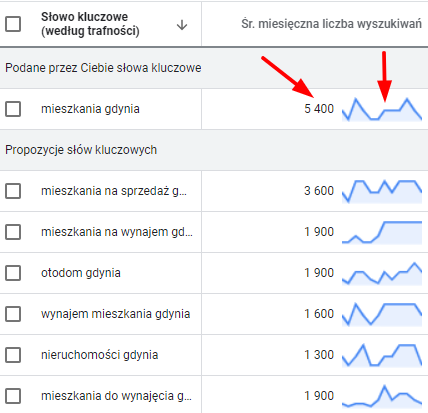 .
.
However, in order to make the estimation more precise, it should be broken down on a monthly basis due to the fact that the number of searches for a keyword varies more or less depending on the period of the year (seasonality).
Estimation of SEO results – Summary
.
As you can see, the factors affecting final SEO result are quite numerous. Some of them, as a rule, have a significant impact on the final estimation result, while some can be ignored in favor of a more simplified version of the estimation. However, it is important to keep in mind that each case is individual, and it may be that seemingly unimportant elements can determine the results for a particular keyword.
 Wojciech Wladziński-Ulatowski
Wojciech Wladziński-Ulatowski